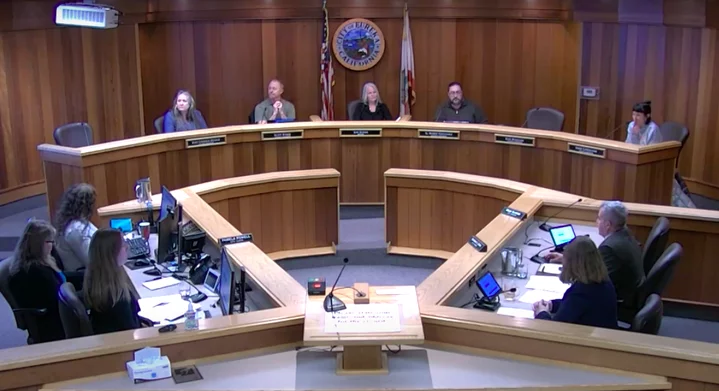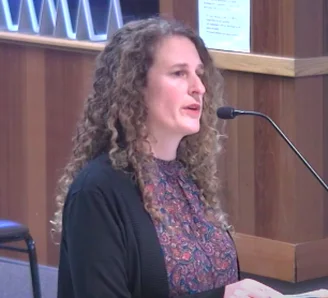Screenshot of Tuesday’s Eureka City Council meeting.
###
The Eureka City Council convened for its first meeting of the year on Tuesday evening. Although it was a relatively light agenda with few action items, the council had the chance to explore some interesting topics, including “fishutopias,” the community benefits of participatory budgeting and the possibility of decriminalizing “natural” psychedelics.
Let’s take a look!
First Slough Fish Passage and Preservation Connectivity Project
Wouldn’t it be nice if our local fish populations had some more habitat to enjoy around Eureka? Fewer barriers and some big fish-friendly culverts to swim through, perhaps? City staff unveiled a project proposal on Tuesday night that would do just that.
The First Slough Fish Passage and Preservation Connectivity Project is a big restoration project that would remove barriers to fish passage along the First Slough, a tributary finger of the Eureka Slough, and allow fish to migrate through Cooper Gulch and upstream to the Eureka High School campus.
If you recall, the city installed a big fish-friendly culvert underneath Myrtle Avenue in 2019. This project furthers that effort to include the Cooper Gulch habitat area and additional barriers beneath Fourteenth, M and N streets in Ross Park neighborhoods. The existing culverts at Fourteenth Street and M Street would be replaced, whereas the existing culvert at the N Street crossing would be removed entirely.
“By removing these barriers, we will be creating an additional one mile of anadromous habitat within the City of Eureka, which is targeting non-natal coho salmon and other anadromous species that are really imperiled state and federally listed endangered species,” said Andrea Hilton, environmental scientist and planner for GHD Group. “There’s this critical ecotone where the brackish waters coming up from Eureka Slough through lower First Slough mix with the freshwater habitat, and that’s like ‘fishutopia’ for little juvenile salmonids.”
Typically, the city would have to go through the CEQA (California Environmental Quality Act) process for such a project. However, because the project is focused exclusively on restoration, it is statutorily exempt in accordance with the California Department of Fish and Wildlife’s (CDFW) Statutory Exemption for Restoration Projects (SERP) process. Part of that process, Allen said, is meeting with local governmental agencies, tribes and stakeholders.
“This project enjoys a wide variety of support from state and federal agencies,” Allen continued. “We’ve received letters of support from Assemblymember Jim Wood, Senator [Mike] McGuire, Congressman Jared Huffman, Senator Alex Padilla, [CDFW], former county supervisor Virginia Bass-Jackson and Cooper Gulch Common Ground, which is a local neighborhood group. … We’re actively working with the city to seek approximately $5 million in construction funds to implement this project.”
During public comment, Eureka resident Joan Carpenter offered her support for the project and emphasized the “wonderful and underappreciated natural resource values” of the proposed project area.
“Based on some study I did of watersheds in Humboldt Bay, it’s also probably habitat not only for the [salmonids] but for the lamprey, which were an important traditional food source. So you might want to add that to the plus side of the project because Lampreys are often overlooked.”
Carpenter also suggested the city “take on a more holistic management plan of the watershed” to address some of the environmental degradation and hazardous waste associated with encampments throughout the project area.
Councilmember Leslie Castellano, likewise, expressed her enthusiastic support for the project.
“I want to thank Director [Brian] Gerving for really thinking ahead when we did have that big construction on Myrtle and that we were able to restore the habit there because this wouldn’t be possible if that wasn’t done,” she said. “Also, I’m really excited about sloughs! It would be neat to have something like ‘Slough Days’ or, maybe that’s not the best, but it’s something to think about.”
The council did not vote on the item.
Participatory Budgeting
The results of the city’s first participatory budgeting process are in, folks!
For the last few months, a group of 25 community members has worked with the City of Eureka to determine how the city should spend a $75,000 chunk of this year’s budget to improve the quality of life in their neighborhoods. The top five projects selected focus on traffic safety and alternative housing.
The bulk of the funding – $45,000 – will go toward rental and utility assistance for folks in need. Those funds are expected to roll out sometime next month. The remaining $30,000 will be divvied up as follows:
- $10,000 will go toward the creation of a tiny home village and/or a city-sanctioned encampment for people experiencing homelessness. The city hopes to get the ball rolling sometime in May.
- $10,000 for RFFBs, or Rectangular Rapid Flashing Beacons, to improve traffic safety at California and Wabash streets. The RFFB will be installed sometime in March.
- $10,000 for an intersection mural at
X and West Fourth StreetSummer and 14th streets. The city still has to find an artist to paint the mural and acquire supplies, but it should be underway in June. [My fault. —Ed.]
“We did learn a lot through this process,” said City Manager Miles Slattery. “If this happens to go through their next strategic visioning and this becomes a priority for counsel and we want to do this again we definitely took notes and have an understanding of some of the areas where we could have improved. Obviously, more participation is what we’d like to get out of this.”
The council unanimously approved the $75,000 funding allocation in a 4-0 vote, with Moulton absent.
Lundbar Hills Development Project
The council also considered a request to extend a development agreement for the Lundbar Hills Subdivision at the south end of town, near the golf course. The development agreement concerns “Southwood Unit No. 6” of the subdivision which is set to expire next month.
“The application … was conditionally approved in 2007 to subdivide 19 relatively flat hilltop acres into 56 new lots ranging in size from 6,500 to 49,000 square feet with the remainder parcel retaining 8.5 acres,” said principal planner Cristin Kenyon. “Since 2016, the city has issued two statutory exemptions, the most recent of which was approved in 2021 for a one-year extension that’s set to expire on February 20 of this year. … The development agreement is proposed to extend the life of the approved subdivision map another 10 years.”
Lundbar Hills Southwood Unit No. 6. | Screenshot
Castellano asked why the development had not taken place within the allotted time frame. Property owner Will Burnam said it was a matter of weighing “investment and economic risk” as another recession looms ahead. Burnam also acknowledged the recent passing of his father who initiated the Lundbar Hills Subdivision development over fifty years ago.
“This particular project, in today’s dollars, would be in excess of $4 million,” he said. “What do I get by making the investment and taking the economic risk? … It’s scary right now. We’d like to get some advantage with all the good things we see in the near future with offshore wind, Cal Poly Humboldt and the Nordic fish farm. … It just comes down to that.”
After a brief conversation, the council ultimately approved the introductory item in a unanimous 4-0 vote, with Councilmember Kati Moulton absent. The development agreement will come back to the council for further discussion in the near future.
SB 58: Decriminalizing Psychedelics
While discussing recent legislative actions at the state level, Bauer asked if the council would consider supporting Senate Bill 58, which seeks to decriminalize the possession and personal use of certain psychedelic drugs, including psilocybin, psilocin, Dimethyltryptamine (DMT), mescaline (excluding peyote) and ibogaine.
Several California cities have already decriminalized “natural” psychedelics, including Oakland, San Francisco and Santa Cruz. Similarly, the Arcata City Council voted to decriminalize the use of entheogenic plants and fungi in the city in October 2021.
“I feel like it’s important to consider this, to support it, and I say that thinking about the [veterans] out there in our community,” he said. “There are a million studies that show that the use of these substances in a controlled setting helps people with [post-traumatic stress disorder]. Not just vets, but terminally ill cancer patients.”
Bauer emphasized the need to help people that aren’t having success with other treatment methods. “I think about a colleague of mine who committed suicide and he was on a prescription medication and I think he saw no other way out,” he continued. “I’ve heard about this before, that it can help people rewire their brains and give them another opportunity, a different life.”
The bill was introduced last year but did not make it through the Senate. It is currently held up in the Senate Rules Committee.
City attorney Autumn Luna suggested the council revisit the subject at a future council meeting. The council offered three thumbs-ups in agreement.
###
The council also received a rundown on the fourth installment of the city’s Coastal Land Use Plan, which focused on the “Coastal Core Area.” The council still has three additional chapters to review before reviewing the draft plan in its entirety.
###
You can find a recording of Tuesday’s meeting here.



CLICK TO MANAGE